Stucco and the blind man
Chapter 8: Planning a plaster or a stucco project.
It all begins with a plan.
No, I'm not going to tell you how to stucco a house, but the planning.
Remember the 5 P's: Prior Planning Prevents Poor Performance.
A major expense or stucco or any construction project is scaffolding. Scaffold is one thing that is largely neglected by contractors. Underestimating scaffold costs is a leading cause of failure for contractors. Often times scaffold costs are overlooked, due to plans that are unclear, or just inexperience of the person estimating. Scaffold could also be a deal-breaker which to be taken into consideration when estimating jobs.
One needs to avoid impossible projects. For example, I was called to estimate repairing a badly water damaged plaster molding in a church sanctuary in Fairfax, Virginia. I figured it would take 4 days to set up the scaffold. The church was used by two congregations, one on Saturday and one on Sunday. They gave me the condition that I'd have to have the scaffold down and everything cleaned up by Saturday for example I start on a Monday I would have to have all the scaffold taken down and cleaned up by Saturday, so there wasn't any time to do any plastering.
Another impossible contract:
Years ago, I was estimating lath and plaster ceilings in a government building. Working hours in this building were four in the afternoon to 12:00 midnight. The deal breaking condition was the scaffold would need to be set up taken down in the floors mopped before 12:00 midnight. There wasn't time to do the work. It would take over 6 hours just to set up the scaffold. If you can't set up the scaffold and leave it in place during the duration of the work, you might as well not even do the job. I call these impossible contracts that should be avoided.
Other reasons for impossible jobs are lack of staging area, absurd specifications, nasty neighbors, etc. All building trades need some staging area, that is, a place to put scaffold, materials, tools, etc. This includes access to the job during working hours, water, etc.
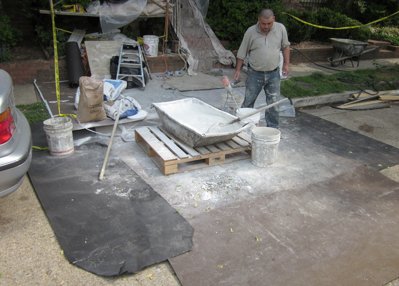
Here, we mixed mortar in the street in Old town Alexandria, Virginia. After the scaffold was set up there was no more room. This may be illegal in Washington, DC, or other cities.
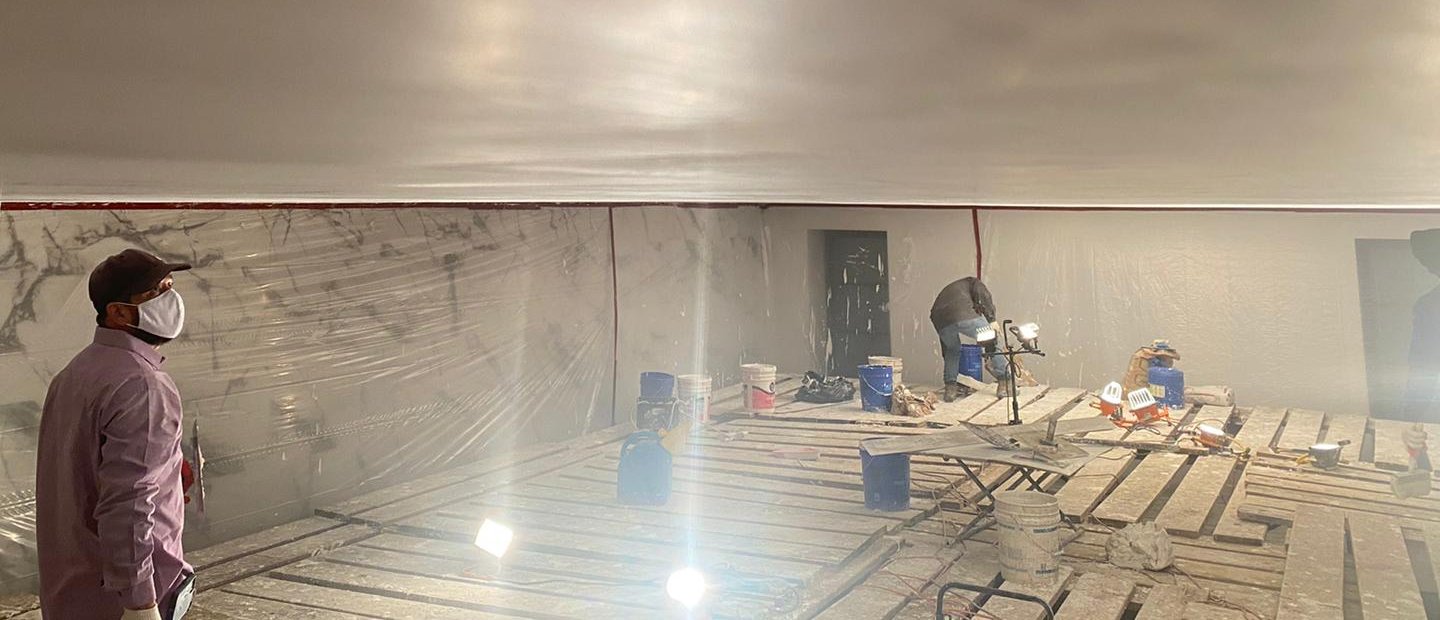
The scaffold under this shiny new plaster ceiling is like a floor. One can walk around and reach and touch every part of this ceiling until it is finished. There is room on this scaffold for three plasterers, mortar, tools, etc. Plaster (and cement plaster) ceilings have a large scaffold requirement.
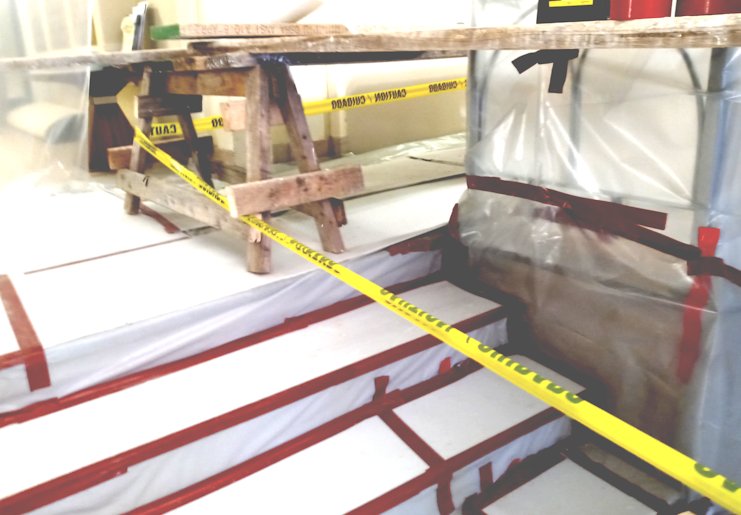
Home made trestle type scaffold for plaster. Saw horses are called trestles in plastering. These trestles were custom made for the varying ceiling height. Floors are first covered with plastic, then covered with correx. Correx is easy to cut as is great for stairways because it can be cut to fit. All this covering and protection and custom made scaffold needs to be taken into consideration when planning a plaster job.
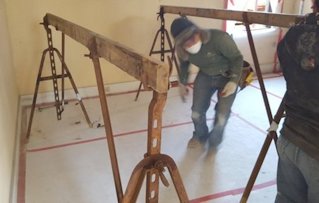
Jack and batt type scaffold. Plaster jacks vary the ceiling height. The boards stood on the side are called batts. Note the floor underneath is first covered with plastic, then covered with correx. Plaster jacks haven't been made since 1951.
Another deal killer is ridiculous specifications. Most commercial bid type jobs these days have absurd specifications. For example, 10 times more sand than you should put in the mortar, products that don't exist, etc. I have done jobs like this anyway, but have had some conflicts. I simply don't do government-type historic jobs anymore. This is another reason the commercial bid system is broken.
Sure, most places don't hold you to the specs, but I just don't take a chance anymore. I got a bid invitation several years ago for stucco on a historic battlefield close to me. The specs called for plastic expansion joints placed vertically every 8 feet, and a mortar mix that wasn't even close. The stucco work looks like a bunch of kids did it. The mortar has come loose from the chimney and the stucco is tied on with wire. Another reason the bid system is broken, besides ridiculous specs, is that inexperienced contractors are welcome to bid on the work, and of course the public suffers. Sometimes these are EIFS contractors who have no business doing stucco. More about this some other time.
Information in specifications is handed down, copy and paste, and doesn't usually make sense. A simple web search containing the word stucco will produce a huge volume of regurgitated false information. Here in the misinformation age, this information is poured out in milliseconds. I am afraid AI will bring 10 times the regurgitation.
Another important thing to take into consideration in planning is scaffold permits.
We went down to Richmond, Virginia to stucco the front of an old building. There was a wide sidewalk with plenty of room to walk around so I didn't think anything about blocking the sidewalk. We were building scaffold on a sidewalk in the front of a building 2 or 3 hours when someone came from the City of Richmond government with a uniform to tell us we had to take the scaffold down because we didn't have a permit. Getting a permit required making a drawing of the scaffold, which the building owner did, and have it approved by the Richmond Government. This took about two weeks and created an unexpected delay.
Washington D.C. has stricter laws. In D.C., most scaffolds require a public space permit. One important thing I must share with you, and most people don't realize, that a large part of their yard is in public space. On most townhouses in Washington DC everything from the front door forward is public space. On single family houses, for example in the Foxhall Road area, public space extends about 18 ft into the yard.
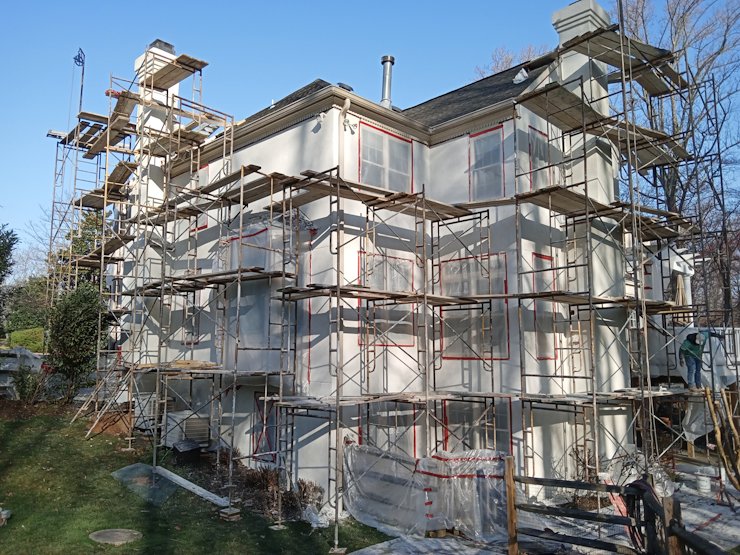
Scaffold for stucco is set up where each level can be walked end to end without bending and crawling. Mortar sets fast and there is no time for moving, crawling, climbing, etc.
We stuccoed a big house in Cleveland Park where the public space extended 12 feet into the yard. I didn't need a scaffold permit, but I couldn't leave scaffold near the curb. I had to move my scaffold over a few feet because a neighbor called DCRA and complained. In D.C., a public space permit applies not only to sidewalks, but DC public space, which is the front yard of the house where the scaffold is set up. If the scaffold is 20 feet high, getting a scaffold permit requires a shop drawing of the scaffold and a stuctural engineer's stamp. One work around for not having to get a public space scaffold permit is, if the yard we're working on has a locking or lockable gate, no permit is required.
We built a scaffold once about 4 inches into the neighbor's yard while we were working on a townhouse. The neighbor told me that I couldn't build a scaffold in his yard. I had to tell him I'm sorry, it's not your yard. I had a copy of the plat and the scaffold permit that gave me permission to build scaffold in his yard.
One thing a contractor can take advantage of is the public space between the sidewalk and the curb. This could be used for temporarily storing materials, trash bags, or whatever. It's a good idea not to smash somebody's plants even though you legally can, because it isn't their space.
Another very important thing for planning or setting up a stucco job is noise ordinances. These noise ordinances vary from County to County, City to city. In Washington D.C., the noise ordinance says you can make all the noise you want at 7:00 Saturday morning, but again why wake people up and piss them off because you have a legal right to do it.
There are restrictions on Saturdays, Sundays, and holidays, so one should be aware of these restrictions. A contractor could be fined and have a stop work order put on the job for violating the noise ordinance. You can work on little known holidays pretty much anytime in Fairfax County, Virginia, but you can't make noise so loud it could be here heard of the neighboring house with the doors closed until 9:00 a.m. In Arlington County, it is illegal to make any noise, period, until 11:00 a.m. on holidays and Saturdays. One thing to realize also is that Black Friday is a legal holiday. I think it's indigenous people's day or something. It was signed into law by George Bush. We were working in Chevy Chase, Maryland, on Black Friday and the police came over and told us to stop working or he would put a stop work order in the building. I was really shocked. I remember when everybody went back to work the Friday after Thanksgiving. These delays are something else that should be estimated into your jobs when planning a job. This could really cause you damage.
Sometimes a scaffold cost more than the stucco itself. imagine a patch on a ceiling over a 7 story high stairway. We set up a scaffold for a ceiling over a stairway in the Internal Revenue Building in Washington, D.C. for a patch in the ceiling. If I fell off the scaffold it would be a seven-story drop all the way to the bottom. I did the patch by taking 16-ft boards up to stairway because they wouldn't fit in the elevator. It took us five days to set up a scaffold and only took me an hour to do the patch. Of course I didn't waste a lot of time up there, it was kind of scary. This is a good illustration that scaffold can cost a lot more than the plastering itself. By the way, somebody patched the ceiling before me by stuffing an old plaster bag in the ceiling it and plastering over it. The ceiling may not have failed if they put up metal lath. I noticed a couple years later they finally started putting on a new roof in the building to fix the leak.
Plaster ceilings have difficult scaffold requirements. On a plaster ceiling, one would need to be able to reach one end of the ceiling all the way to the other safely and comfortably.without stopping to move scaffold. This may not be necessary with drywall or other materials. The height of the scaffold for a plaster ceiling should allow the tallest plasterer to work without stooping. The ceiling should be no lessches than 6 in over his head. We used to build scaffolds in an angle for a short and a tall plasterer, namely me, I'm 6'4" with a short guy on the other side.
Ceilings in commercial buildings require a lot of a scaffold. Church sanctuarys, for example, have unique scaffold requirements and the scaffolding should be taken into consideration before one determines whether you're going to accept a job that may not be practical. Professional scaffold companies should be brought in whenever there is a big or unusual scaffold.
There's an expression in Richmond: If you build the scaffold, I'll white coat the sky. A lot of people don't catch the meaning of this. If you call me and want to do want me to do a little small patch on a four-story building, I need some way to get up there. I prefer to put mortar on the wall instead of building scaffold. I prefer to leave to a professional company professional scaffold Builders. Our time is better spent putting more than the wall.
If someone calls with a little patch that is, say, 4 stories high, and can be done with a snorkel lift, also known as a cherry picker. For example, a patch that can be done with a half bucket of mortar or so, they would need to supply the lift. My time should be spent putting on mortar and not getting the lift delivered or paying for it. Besides, it is only good business to work for people that have some skin in the game.
One thing is completely useless for outside stucco is a scissors lift, that is, a lift with a platform of say, about 4 ft. by 10 ft. These are too slow and they probably do more harm than good. One main problem with the lifts is they are way too slow. Many years ago I worked for a company that stuccoed a big wall on the back of a shopping center. Two plasterers and a mortar board would barely fit on the lift. We have to go down constantly so somebody could shovel mortar on the mortar board. Then we would stand there until the board was loaded and then go back up put that mortar on. This took forever. We could only reach so much without raising and lowering the lift. The lift was always getting flat tires, and someone from the lift rental place would come down and fix the flats. The platform was metal and impossible to clean once mortar got gobbed on. The thing got stuck once probably from dripping mortar into the hydraulics and we had to wait until somebody got us down with a ladder. The wall was broken into 10 ft squares, so we did one 10 ft panel at a time. It took months to finish the job. These may work well for a small patch, but the expense of transporting and the rent would make it more impractical.
Pump jacks, also known as kick jacks should never, ever, ever be used for stucco. They are entirely too dangerous and are not designed for heavy materials. They also crank down real slow. One wouldn't be able to crank the thing down fast enough to avoid leaving a join, or a nasty seam when putting on the finish coat. They may be okay for siding which is lightweight, and you start from the bottom up, and cranking the work platform down isn't a challenge. These are really shaky I don't see how more than one person can work on them. Doing stucco work you need room for mortar boards,water buckets, tools, rods, etc. There is simply nowhere to put anything, and the stuff is way too heavy for the jacks to support. They're also way too shaky to use for a pulley with mortar. Also, aluminum pick boards get gobbed with mortar and won't clean off.
I saw a serious injury once with kick jacks. The two by fours spliced together supporting the kick jacks broke and three people fell to the ground. I was working inside of a bay window in Fairfax Virginia and saw this happen. They weren't using aluminum poles before but two by fours overlapped and nailed together. At least two of them were paralyzed for life. This is something I'll never forget. So don't ask me why I don't ever want to work on kick jacks.
Scaffold with wheels shouldn't be used for plastering if a pulley is used to hoist the mortar. Even though the wheels lock, the wheels still pivot on the axle. A scaffold top heavy with plasterers and mortar can be pulled over. At best, the scaffold will shake too bad.
Stilts should never be used for inside plaster. A lot of mortar drips on the floor and it is way too slippery. Not to mention, there are too many things to deal with, like mortar boards, water buckets, rods, etc. I saw a serious disaster when someone was using stilts to brown coat a ceiling. He was rodding off a ceiling walking backwards with a 6 foot rod full of mortar and fell right over.
Requirements for protecting and covering areas like sidewalks, patios, roofs, etc. are important to determine in the planning stage,
Just imagine stucco on a 5-ft high knee wall around a swimming pool where there's no scaffold required. If you're working on top of tiles that scratch and chip easily, not to mention near impossible to clean mortar off, special preparation needs to be made for covering and protecting the tiles.
You would need more than a piece of plastic spread out the procedure for us here would be to spread her plastic out and tape it down and cover that with correx. Correx is corrugated plastic sheets. If we can't get correx, masonite will work but correx is far more practical. I really don't know how we survived before correx was invented. Masonite works good also to cushion blow, and prevent damage but it doesn't last working outside. Correx has the resistance of masonite, but it's plastic, a lot lighter, and it can be cleaned off and reused over and over. Usually a sheet of correx gets three or four uses from us before it's pitched. Correx is excellent for stairways because it can be cut easily with a knife to conform to stairs, and floors, and taped down.
We use correx, also for covering windows when we demo stucco to prevent damage to the window.
When putting on stucco, the windows need to be covered. We cover the windows, doors, etc. with plastic and red stucco tape. It is important to cover modern screens. If the screensgets mortar on them they're usually completely ruined. Trying to clean the mortar off rips the damages the screen. It's a lot cheaper to cover up than to cleanup. You may have seen the red tape that we use on my website. This is called stucco tape, but you could use it for other things besides stucco. Stucco tape is designed not to leave adhesive residue on metal or other surfaces. The tape is strong enough to hold plastic up and comes off pretty easily nearly all the time.
One should never use duct tape. It's far harder to get the duct tape residue off than the mortar. You want to make sure that it's a red stucco tape and not cloth tape. Someone in Alexandria saw us using red tape and went to Home Depot and got cloth tape to put on a old historic building that had brickwork from the 1870's. I don't know how he got the cloth residue off but it was stuck on there really good. It did damage to the surface of the brick. stucco.
Red tape has become indispensible to us for covering and protecting surfaces from mortar. I used to mail order it from walls and ceilings magazine 30-35 years ago before the web was invented. Red tape is now available in paint stores, some Home Depots and most building supplies that sell plastering materials. If you can't find red tape, it is available from Nathan Kimmel, the plasterer's supermarket, in Los Angeles.
Styrofoam also has become invaluable for covering roofs such as metal roofs, slate roofs, Spanish tile roofs. Styrofoam is also great for covering any kind of stones or things that will damage or scratch easily. I used to get styrofoam for free from a building supply. Whenever there was a wind storm, the styrofoam blew around and broke up. I got all the broken sheets they couldn't sell for free. I have done this for years. Finally, they got hip and developed a plastic net to cover the foam to prevent them from blowing around. So now I have to buy the stuff like everybody else. Still, styrofoam is a lot less cheaper than repairing even replacing slate or Spanish roof tile.
Aluminum roofs dent easily, and the factory baked on finish scratches easily. There is styrofoam called scoreboard that can be scored and snapped on 16-in centers or 24-in centers. Usually the ribs of a aluminum roof are 16 inches on center, so scoreboard works well. We usually cover the roof with styrofoam between the ribs that projects up past the ribs. That is, the foam is thicker than the ribs on the roof. Then, if necessary, we put more foam sheets and correx boards over the foam between the ribs, and put scaffold boards on top.
You may have seen on my site, the idea of using sandbags in the channels on Spanish tiles. A reader from California sent this and it works excellent. Since then, we have been using three inch styrofoam to fit into channels of the Spanish tile roof. On top of that, we spread out a thick sheet of styrofoam, then a sheet of correx, then put down scaffold boards to spread the weight of the scaffold we build on top.
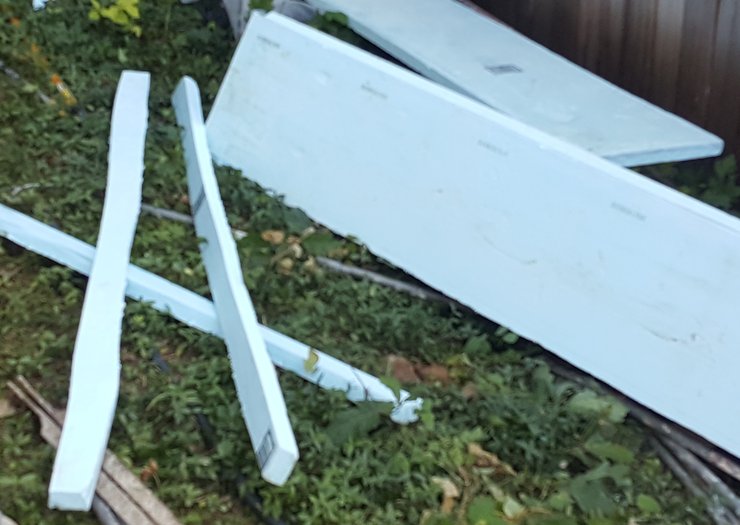
styrofoam is cut into strips to fit into the channels of a Spanish tile roof. Here's a link to how we did this.
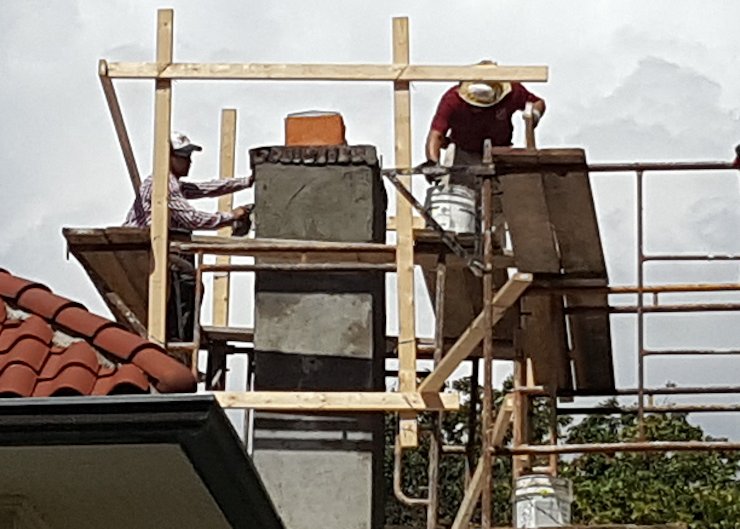
We scaffolded off this chimney, without a single teeny crack on the roof.
Another method for Spanish barrel tiles on new construction, is to put on the roof before the stucco, or at least load the roof down with tiles before the stucco application. These tiles are heavy and the weight on the roof could bow the studs and damage the stucco easily.
I saw in California where roofs were loaded down before stucco application. The tiles were arranged about two tiles high on pallets. The pallets were spread around the roof leave by a forklift truck to weight the roof down. This allowed to stucco to proceed before the roof.
Here's another comment about Spanish tile, which may be a little off the subject. Years ago we worked when a house in Great Falls, Virginia. The owner ordered barrel tiles from some company in a distant state, I think Wisconsin or somewhere. The instructions from the factory said the tiles would arrive in an air ride truck. Someone would have to have a forklift on the site when the truck got there. Then, while the forklift was still there, the tile should be arranged about two tiles deep on pallets. Then, the pallets are forklifted up to the roof. You can't lift a whole pallet of Spanish tile on the roof because it would go right through the roof. These are really heavy. I saw these instructions and laughed. I saw how Spanish tile were done in Mexico, and it was far more efficient. A truck would show up with the tile and back up close to the house. One person on the truck would throw the tiles up to somebody on the roof who would catch him and carry them over to the person nailing. This went incredibly efficiently, and was no need to move heavy tiles three or four times. The tiles were put right where they go, right in place to be nailed. This is such an great idea, but it's not really known here
Slate roofs what are the same thing. Slate is a very heavy material, and the roof should be loaded down before the stucco application. Slate breaks easily, and needs to be covered with styrofoam and protected just like Spanish tile. I have broken a few slates in my life, but none lately.
Sidewalks, patios, etc. need to be covered to avoid mortar splattering. Before we started using correx, we put plastic down first and used masonite or plywood on top. I used to get plywood for free from people that was used for temporary construction barriers, temporary entrances to buildings, and so forth. I mean to tell you this plywood gets heavy after after 2 or 3 times from soaking in mortar. It's another albatross around your neck to reuse plywood or even masonite because these materials are difficult to move and store. We even drop cloths outside, even though they didn't really last very long.
Free plywood died back about 2004 the supply was short and the price went sky high. People started using plywood down to the last little teeny scrap. Old man Free Plywood died.
Tar paper guitar is great for shingle roofs, asphalt, etc. Tar paper is good for this. It can be taped down, and it's not too slippery. It's a good idea, also, to have a few clean drop cloths on hand. Bear in mind, mortar does not like to come off of shingles. I've heard the old bricklayer story, "Oh, the rain will take it off." I quit believing that story a long time ago.
An old fashioned method of bonding to concrete is Portland cement paste. I learned this from the old guy at the hospital. This method of bonding was used many years ago and swimming pool construction and for bonding stucco to concrete or interior plaster to concrete. First a paste is made with Portland cement and water the consistency that you can put on .
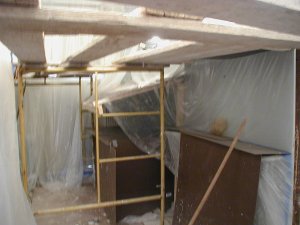
We built boxes over a piano made in 1820 and a fireplace made in 1850 to avoid damage. We replaced ceilings in a historic museum in Alexandria, Virginia. Here's a link to more:
We build boxes and similar protection over air conditioning units and heat pumps. It is important to cover the sides of these while working to avoid splattering mortar on the coils. These coils are almost impossible to clean off. The electricity can be turned off on these units by pulling out the fuses.
I can go on and on, but hopefully I have communicated the importance of planning.
Thanks so much dear readers, for reading all these years.